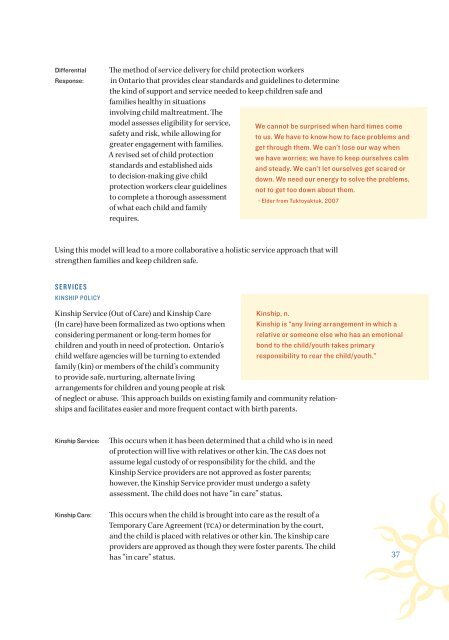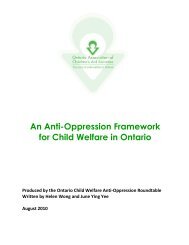English - Ontario Association of Children's Aid Societies
English - Ontario Association of Children's Aid Societies
English - Ontario Association of Children's Aid Societies
You also want an ePaper? Increase the reach of your titles
YUMPU automatically turns print PDFs into web optimized ePapers that Google loves.
Differential<br />
Response:<br />
The method <strong>of</strong> service delivery for child protection workers<br />
in <strong>Ontario</strong> that provides clear standards and guidelines to determine<br />
the kind <strong>of</strong> support and service needed to keep children safe and<br />
families healthy in situations<br />
involving child maltreatment. The<br />
model assesses eligibility for service, We cannot be surprised when hard times come<br />
safety and risk, while allowing for<br />
to us. We have to know how to face problems and<br />
greater engagement with families. get through them. We can’t lose our way when<br />
A revised set <strong>of</strong> child protection<br />
we have worries; we have to keep ourselves calm<br />
standards and established aids<br />
and steady. We can’t let ourselves get scared or<br />
to decision-making give child<br />
down. We need our energy to solve the problems,<br />
protection workers clear guidelines not to get too down about them.<br />
to complete a thorough assessment<br />
- Elder from Tuktoyaktuk, 2007<br />
<strong>of</strong> what each child and family<br />
requires.<br />
Using this model will lead to a more collaborative a holistic service approach that will<br />
strengthen families and keep children safe.<br />
SERVICES<br />
KINSHIP POLICY<br />
Kinship Service (Out <strong>of</strong> Care) and Kinship Care<br />
(In care) have been formalized as two options when<br />
considering permanent or long-term homes for<br />
children and youth in need <strong>of</strong> protection. <strong>Ontario</strong>’s<br />
child welfare agencies will be turning to extended<br />
family (kin) or members <strong>of</strong> the child’s community<br />
to provide safe, nurturing, alternate living<br />
arrangements for children and young people at risk<br />
Kinship, n.<br />
Kinship is “any living arrangement in which a<br />
relative or someone else who has an emotional<br />
bond to the child/youth takes primary<br />
responsibility to rear the child/youth.”<br />
<strong>of</strong> neglect or abuse. This approach builds on existing family and community relationships<br />
and facilitates easier and more frequent contact with birth parents.<br />
Kinship Service:<br />
Kinship Care:<br />
This occurs when it has been determined that a child who is in need<br />
<strong>of</strong> protection will live with relatives or other kin. The CAS does not<br />
assume legal custody <strong>of</strong> or responsibility for the child, and the<br />
Kinship Service providers are not approved as foster parents;<br />
however, the Kinship Service provider must undergo a safety<br />
assessment. The child does not have “in care” status.<br />
This occurs when the child is brought into care as the result <strong>of</strong> a<br />
Temporary Care Agreement (TCA) or determination by the court,<br />
and the child is placed with relatives or other kin. The kinship care<br />
providers are approved as though they were foster parents. The child<br />
has “in care” status.<br />
37

















